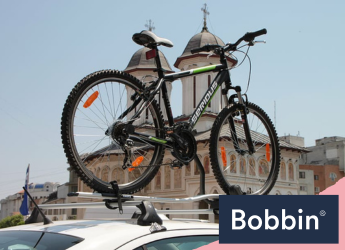How to Secure a Kid’s Bike on the Roof
Family adventures often involve biking, but what if you want to take your kids bike along on a road trip? Securing a child’s tow-wheel companion on the roof of your car can be a game-changer. It allows you to explore new destinations without leaving the little rider’s ride.
Ensuring the safety of the bicycle and the road requires the right knowledge and tools. In this guide, we’ll walk you through the essential steps to transport a kid’s bike on the roof securely. Read on to make sure your journey’s safer and more enjoyable for your next bike ride plan with the whole family!
Choosing the Right Roof Rack

The right roof rack is vital when securing a kids hybrid bike safely for your family adventures. A well-suited roof rack ensures stability and ease of installation. Moreover, it minimises the risk of damage to the bike and car.
There are two primary types of roof racks:
- roof-mounted bike racks
- roof crossbars
Roof-mounted bike racks provide a dedicated space for the bike, even if it’s a balance bike. All in all, it keeps it separate from other cargo. Roof crossbars, in contrast, serve as a versatile base for various attachments.
Consider your car’s make and model, as well as your kids bike size and weight. Ensure compatibility and weight capacity by consulting your vehicle’s manual. And, of course, the roof rack manufacturer’s guidelines.
Opt for a design that suits your family’s needs. It could be for frequent bike trips or other cargo-carrying purposes. A well-chosen roof rack sets the foundation for a secure biking experience on the road.
Preparing the Bike
Preparing the kid’s bike before securing it to the roof ensures a safe and damage-free journey. Neglecting this preparation can lead to unnecessary wear and tear on the bike. Even worse, to potential hazards during transport.
To start, clean the Bobbin Brownie, for instance, thoroughly. Doing so can prevent dirt and debris from scratching the frame or components. Also, remove loose bike accessories, such as the insulated cycling water bottle. It can become dislodged during transit and pose a safety risk on the road.
Additionally, consider using a bike cover or padding. This attachment can shield the bike from road debris, insects, and other elements.
Steps for Securing

(Image Credit: Dirtbag Cycles)
Follow these step-by-step instructions to ensure a secure attachment:
1. Mounting the bike on the roof rack
- Start by lifting the kid’s bike onto the roof rack.
- Align the wheels with the designated slots or cradles on the rack.
- Ensure the 20” bike, for instance, is centred on the rack and parallel to the vehicle.
2. Positioning and securing the bike’s wheels
- After mounting the bike, secure the wheels using wheel straps or similar mechanisms.
- Tighten the straps to prevent any wobbling or movement during transit.
- Ensure the wheels are securely in place, with no chance of slipping.
3. Securing the frame and handlebars
- Use additional straps or clamps to secure the bike’s frame and handlebars.
- Wrap the straps around the frame, taking care not to over-tighten and damage the bike.
- Secure the handlebars to prevent any unwanted movement or rotation during transport.
4. Double-check all connections and fasteners
- Before hitting the road, inspect all connections. These include the wheel straps, frame clamps, and handlebar restraints.
- Make sure everything is tightly secured. There should be no loose ends or potential points of failure.
- Gently shake the bike to confirm its stability on the roof rack.
Additional Tips for a Safe Journey

Periodically inspect the bike’s attachments and fasteners whenever you make a stop. This precaution helps catch any loosened straps or unexpected shifts. Overall, it ensures the bike remains securely in place.
Keep an eye on the bike through your rearview mirror or, if possible, a roof-mounted bike camera system. This allows you to address any stability issues and avoid potential hazards.
Maintain a safe and moderate driving speed to reduce wind resistance and stress on the bike’s attachment points. Steer clear of adverse weather conditions like heavy rain, strong winds, or storms. For one, this can compromise the bicycle’s security and road safety.
Unloading and Safety Precautions
To do so, follow these steps:
- Park your vehicle on level ground to ensure stability.
- Double-check all attachments to confirm they are secure.
- Carefully release straps and clamps, starting with the handlebars, frame, and wheels.
- Slowly lift the bike off the roof rack. Maintain control to prevent sudden movements.
- Set the bike down gently, avoiding any potential drops or impacts.
By adhering to these precautions, you’ll ensure an incident-free unloading process.
Round-up
Securing a kid’s bike on the roof doesn’t need to be daunting. To embark on family adventures with confidence, make sure to have:
- the right roof rack
- preparation
- proper securing technique
And when you reach your destination, follow safe unloading procedures. By prioritising safety, you’ll enjoy worry-free journeys!
Explore Bobbin for all your biking adventure essentials. We provide a diverse selection of bicycles, along with safety gear like Bobbin helmets and bike lights.
What’s next on your reading list: What Are the Best Bike Sheds for Storage?









